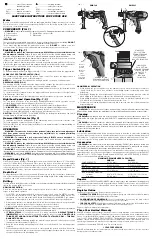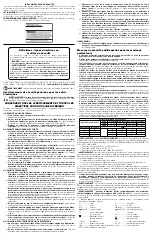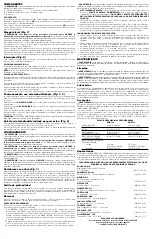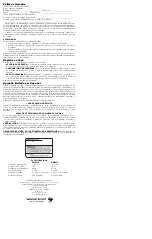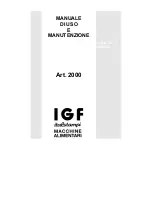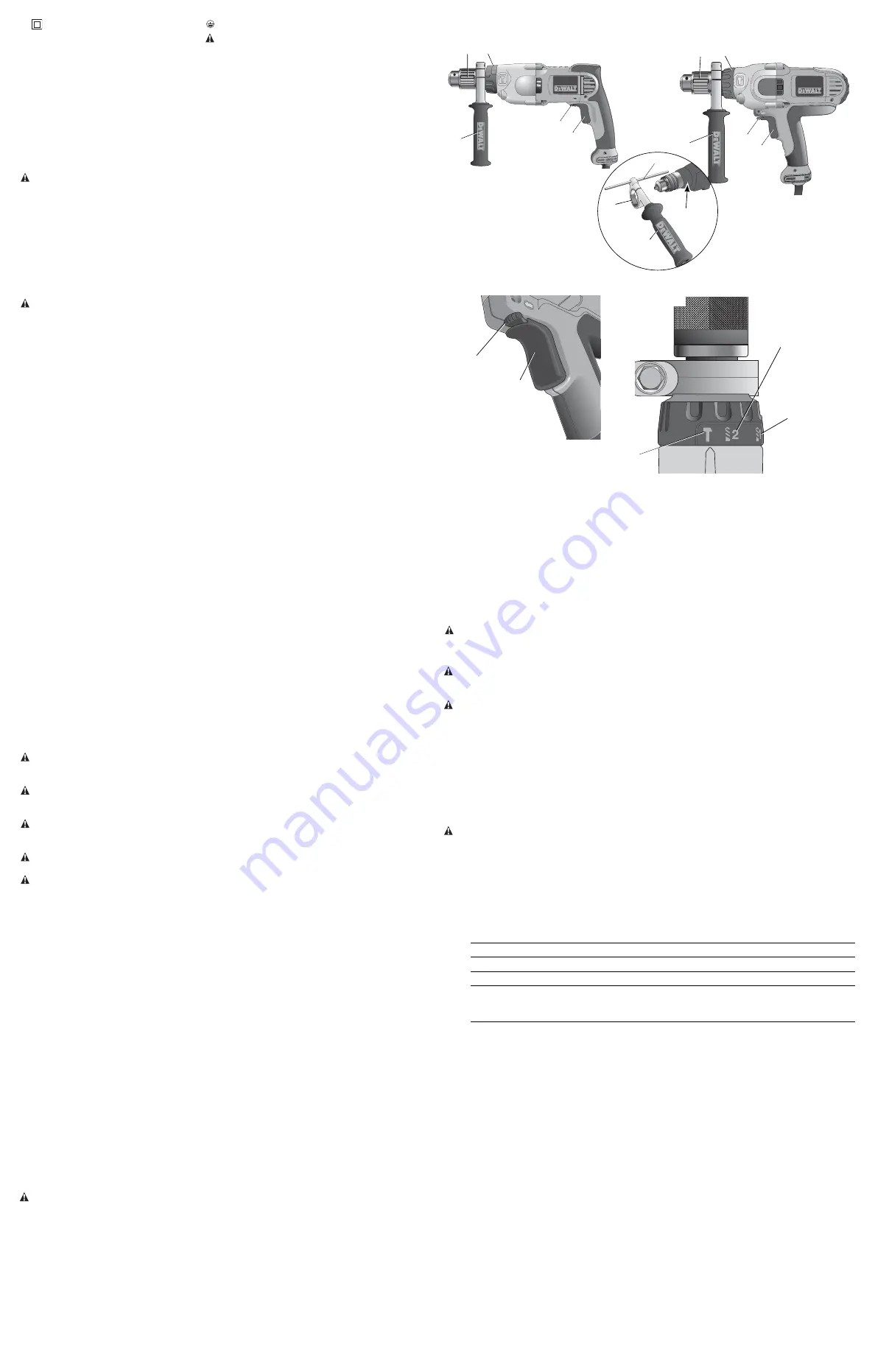
LOW SPEED
DRILL SETTING
RÉGLAGE PERÇAGE
VITESSE RÉDUITE
AJUSTE DE
BROCA
PARA BAJA
VELOCIDAD
...................Class II Construction
.......................earthing terminal
(double insulated)
........................safety alert symbol
…/min ............per minute
BPM ...................beats per minute
IPM .................impacts per minute
RPM ...................revolutions per minute
SPM ...............strokes per minute
sfpm ...................surface feet per minute
SAVE THESE INSTRUCTIONS FOR FUTURE USE
Motor
Be sure your power supply agrees with the nameplate marking. Voltage decrease of more than
10% will cause loss of power and overheating. D
E
WALT tools are factory tested; if this tool does
not operate, check power supply.
COMPONENTS (FIG. 1)
WARNING:
Never modify the power tool or any part of it. Damage or personal injury could result.
A. Trigger switch
D. Speed/Mode selector collar
B. Reversing lever
E. Side handle
C. Chuck
INTENDED USE
These heavy-duty hammerdrills are designed for professional drilling and hammerdrilling.
DO NOT
use under humid conditions or in presence of flammable liquids or gases.
These heavy-duty hammerdrills are professional power tools.
DO NOT
let children come into
contact with the tool. Supervision is required when inexperienced operators use this tool.
Side Handle (Fig. 1)
WARNING: To reduce the risk of personal injury, ALWAYS operate the tool with the side
handle properly installed.
Failure to do so may result in the side handle slipping during tool
operation and subsequent loss of control. Hold tool with both hands to maximize control.
A side handle (E) is supplied with this hammerdrill. It clamps to the front of the gear case as shown
in Figure 1 and can be rotated 360˚ for right- or left- hand use.
After the side handle is rotated into position, it should be pushed rearward until the slots (F) on the
lip of the side handle are aligned and fully engaged with the projecting tabs (G) on the underside of
the gear case. The side handle is then securely clamped by turning clockwise until tight.
Trigger Switch (Fig. 2)
To start hammerdrill, depress the trigger switch (A). To stop hammerdrill, release the trigger switch.
VARIABLE SPEED TRIGGER SWITCH (FIG. 2)
The variable speed trigger switch (A) permits speed control. The farther the trigger switch is
depressed, the higher the speed of the hammerdrill.
NOTE:
Use lower speeds for starting holes, drilling in plastics or ceramics or driving screws.
REVERSING LEVER (FIG. 2)
The reversing lever (B), located above the trigger switch, changes the direction of rotation of the
hammerdrill and is used when backing out screws and jammed drill bits.
To operate the tool in reverse, release the trigger switch and push the lever to the left (when viewed
from the chuck end).
To operate the drill in forward, release the trigger switch and push the lever to the right (when
viewed from the chuck end).
Return the reversing lever to the forward position after all operations in reverse are completed.
High/Low Speed Operation (Fig. 1, 3)
The two speed gear drive in the dual range hammerdrill permits effective operation over an
extended range of applications with greater selection of accessories.
For
LOW SPEED
operation, turn the collar (D) to the drill bit symbol for drilling position 1.
For
HIGH SPEED
operation, turn the collar (D) to the drill bit symbol for drilling position 2.
The gear train has been designed for shifting only when the unit is off. It may be necessary however,
to rotate the chuck slightly by hand to align the gears while turning the collar.
CAUTION:
DO NOT ATTEMPT TO CHANGE SPEEDS by turning the collar when the tool is
running. Doing so will damage the gear train.
Hammer/Drill Selector (Fig. 3)
To switch the tool from the drilling mode to the hammering mode (or vice-versa) rotate the collar
(D) to the applicable symbol as shown in Figure 3.
Turn the collar (D) to the drill bit symbol for drilling or to the hammer symbol for hammerdrilling, as
shown in the figure.
OPERATION
WARNING: To reduce the risk of serious personal injury, turn tool off and disconnect
tool from power source before making any adjustments or removing/installing
attachments or accessories.
WARNING: To reduce the risk of personal injury, ALWAYS ensure workpiece is
anchored or clamped firmly.
If drilling thin material, use a wood “back-up” block to prevent
damage to the material.
WARNING: To reduce the risk of personal injury, ALWAYS operate the tool with the side
handle properly installed.
Failure to do so may result in the side handle slipping during tool
operation and subsequent loss of control. Hold tool with both hands to maximize control.
WARNING:
Do not attempt to tighten or loosen drill bits (or any other accessory) by gripping the
front part of the chuck and turning the tool on. Damage to the chuck and personal injury may occur.
WARNING:
Burn Hazard.
ALWAYS
wear gloves when changing bits. Accessible metal parts on
the tool and bits may get extremely hot during operation. Small bits of broken material may damage
bare hands.
Keyed Chucks (Fig. 1)
Open chuck jaws by turning collar with fingers and insert shank of bit about 3/4" (19 mm) into
chuck (C). Tighten chuck collar by hand. Place chuck key in each of the three holes, and tighten
in clockwise direction. It’s important to tighten chuck with all three holes to prevent slippage. To
release bit, turn chuck key counterclockwise in just one hole, then loosen the chuck by hand. Any
authorized D
E
WALT service center can install a keyless chuck in place of a keyed chuck.
Depth Rod
To adjust the depth rod (H), loosen the handle (E) and move rod so that the distance between the
end of the rod and the end of the bit equals the desired drilling depth. When drilling with depth rod,
stop when end of rod reaches surface of material.
Drilling
Turn the collar to the drill bit symbol for drilling or to the hammer symbol for hammerdrilling. Install and
tighten the desired drill bit in the chuck.
DRILLING OPERATION
Select the desired speed/torque range using the speed selector collar to match the speed and
torque to the planned operation.
1. For WOOD, use twist bits, spade bits, power auger bits or hole saws. For METAL, use high-
speed steel twist drill bits or hole saws. Use a cutting lubricant when drilling metals. The
exceptions are cast iron and brass which should be drilled dry. For MASONRY, use carbide-
tipped bits or masonry bits. A smooth, even flow of dust indicates the proper drilling rate.
2. Always apply pressure in a straight line with the bit. Use enough pressure to keep the drill bit
biting, but do not push hard enough to stall the motor or deflect the bit.
3. Hold tool firmly with both hands to control the twisting action of the drill.
WARNING:
Drill may stall if overloaded causing a sudden twist. Always expect the stall. Grip the
drill firmly with both hands to control the twisting action and avoid injury.
4
. IF DRILL STALLS,
it is usually because it is being overloaded.
RELEASE TRIGGER
IMMEDIATELY,
remove drill bit from work, and determine cause of stalling.
DO NOT CLICK
TRIGGER OFF AND ON IN AN ATTEMPT TO START A STALLED DRILL – THIS CAN
DAMAGE THE DRILL.
5. To minimize stalling or breaking through the material, reduce pressure on drill and ease the bit
through the last fractional part of the hole.
6. Keep the motor running when pulling the bit back out of a drilled hole. This will help prevent
jamming.
7. With variable speed drills there is no need to center punch the point to be drilled. Use a slow
speed to start the hole and accelerate by squeezing the trigger harder when the hole is deep
enough to drill without the bit skipping out.
HAMMERDRILL OPERATION
1. When drilling, use just enough force on the hammer to keep it from bouncing excessively or
“rising” off the bit. Too much force will cause slower drilling speeds, overheating, and a lower
drilling rate.
2. Drill straight, keeping the bit at a right angle to the work. Do not exert side pressure on the bit
when drilling as this will cause clogging of the bit flutes and a slower drilling speed.
3. When drilling deep holes, if the hammer speed starts to drop off, pull the bit partially out of the
hole with the tool still running to help clear debris from the hole.
4. For masonry, use carbide-tipped bits or masonry bits. A smooth even flow of dust indicates the
proper drilling rate.
MAINTENANCE
WARNING:
To reduce the risk of serious personal injury, turn tool off and disconnect tool from
power source before making any adjustments or removing/installing attachments or accessories.
Cleaning
WARNING:
Blow dirt and dust out of all air vents with clean, dry air at least once a week. To
minimize the risk of eye injury, always wear ANSI Z87.1 approved eye protection when performing
this.
WARNING:
Never use solvents or other harsh chemicals for cleaning the non-metallic parts
of the tool. These chemicals may weaken the plastic materials used in these parts. Use a cloth
dampened only with water and mild soap. Never let any liquid get inside the tool; never immerse
any part of the tool into a liquid.
Lubrication
Your tool was properly lubricated before leaving the factory. In from two to six months, depending
upon use, take or send your tool to an authorized service center for a complete cleaning, inspection
and lubrication. Tools used constantly on production jobs will need relubrication more often. Also,
tools “out of service” for long periods should be relubricated before being put back to work.
Accessories
WARNING:
Since accessories, other than those offered by D
E
WALT, have not been tested with
this product, use of such accessories with this tool could be hazardous. To reduce the risk of injury,
only D
E
WALT recommended accessories should be used with this product.
Recommended accessories for use with your tool are available at extra cost from your local dealer or
authorized service center. If you need assistance in locating any accessory, please contact D
E
WALT
Industrial Tool Co., 701 East Joppa Road, Baltimore, MD 21286, call 1-800-4-D
E
WALT (1-800-433-
9258) or visit our website: www.dewalt.com.
MAXIMUM RECOMMENDED CAPACITIES
DWD520
DWD525
CHUCK CAPACITY
1/2" (13 mm)
1/2" (13 mm)
R.P.M.
0–1200 / 0–3500
0–1200 / 0–3500
BITS, METAL DRILLING
1/2" (13 mm) low speed
1/2" (13 mm) low speed
WOOD, FLAT BORING
1-1/2" (40 mm)
1-1/2" (40 mm)
BITS, MASONRY DRILLING
optimum
3/16"–3/8" (5–10 mm)
3/16"–7/16" (10– 11 mm)
maximum
3/4" (20 mm)
3/4" (20 mm)
Repairs
To assure product SAFETY and RELIABILITY, repairs, maintenance and adjustment (including brush
inspection and replacement) should be performed by a D
E
WALT factory service center, a D
E
WALT
authorized service center or other qualified service personnel. Always use identical replacement
parts.
Register Online
Thank you for your purchase. Register your product now for:
•
WARRANTY SERVICE:
Registering your product will help you obtain more efficient warranty
service in case there is a problem with your product.
•
CONFIRMATION OF OWNERSHIP:
In case of an insurance loss, such as fire, flood or theft,
your registration of ownership will serve as your proof of purchase.
•
FOR YOUR SAFETY:
Registering your product will allow us to contact you in the unlikely event
a safety notification is required under the Federal Consumer Safety Act.
Register online at www.dewalt.com/register.
Three Year Limited Warranty
D
E
WALT will repair, without charge, any defects due to faulty materials or workmanship for three
years from the date of purchase. This warranty does not cover part failure due to normal wear or tool
abuse. For further detail of warranty coverage and warranty repair information, visit www.dewalt.
com or call 1-800-4-D
E
WALT (1-800-433-9258). This warranty does not apply to accessories or
damage caused where repairs have been made or attempted by others. This warranty gives you
specific legal rights and you may have other rights which vary in certain states or provinces.
In addition to the warranty, D
E
WALT tools are covered by our:
1 YEAR FREE SERVICE
D
E
WALT will maintain the tool and replace worn parts caused by normal use, for free, any time
during the first year after purchase.
FIG. 1
FIG. 2
B
shown in
forward
position
illustré en
position
avant
mostrada
en posición
adelantada
A
D
A
B
E
C
DWD525
D
A
B
E
C
DWD520
HAMMER SETTING
RÉGLAGE MARTELAGE
AJUSTE DEL MARTILLO
FIG. 3
HIGH SPEED
DRILL SETTING
RÉGLAGE PERÇAGE
HAUTE VITESSE
AJUSTE DE BROCA
PARA ALTA VELOCIDAD
E
F
G
H


